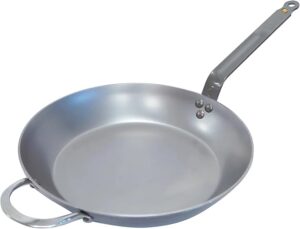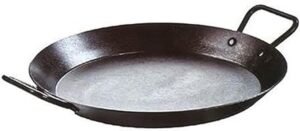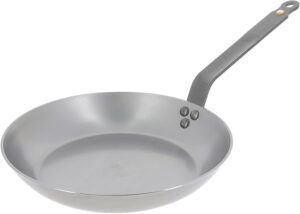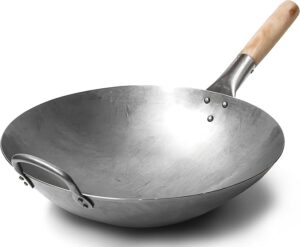Carbon steel skillets are durable, retain heat very well, and cook extremely well but aren’t as heavy as cast iron cookware. That’s why we’ve decided to write this extensive guide on the product so consumers will find pans that will not only help them cook food to perfection but will last them for generations to come. Having said that, below are the best carbon steel skillets currently available, as well as a guide for their general care.
List of the Best Carbon Steel Pans
- Best Frying Pan: De Buyer Mineral B 12.5-Inch Frying Pan (Amazon) – Review
- Best Skillet: Lodge 15-Inch Carbon Steel Skillet (Amazon) – Review
- Best Omelet Pan: De Buyer Mineral B 9.5-Inch Omelet Pan (Amazon) – Review
- Best Wok: Craft Wok Traditional Hand-Hammered Wok (Amazon) – Review
Best Frying Pan: De Buyer Mineral B 12.5-Inch Frying Pan
This carbon steel pan is designed using quality components to create a frying pan that will be appreciated and used for generations to come. It’s oven safe for up to 20-minutes at 400-degrees Fahrenheit and can be used to make a variety of dishes. The carbon steel exterior evenly distributes heat, regardless of whether you’re using a gas or electric range.
This frying pan is capable of handling food with the respect it deserves because of the way it’s made. This pan is made in France using quality carbon steel that’s between 2.5mm and 3mm thick and is naturally PTFE-free and PFOA-free. It’s then coated in a natural beeswax finish that seasons the cooking surface and protects it from corrosion. Another sign that this pan is well made is that its handle isn’t screwed on but is instead riveted. And its rivets are made from carbon steel as well, so they won’t contract and eventually become detached from the pan. This means that this pan is capable of outlasting the consumer and can be passed down as a family heirloom—if it’s properly cleaned and maintained by the consumer.
Best Skillet: Lodge 15-Inch Carbon Steel Skillet
This 15-inch carbon steel skillet from Lodge isn’t your ordinary pan. It’s a model that’s designed to heat evenly and to last through generations of use. It’s a very large pan, so sometimes it feels difficult to use it on stoves, but once the consumer gets used to it, they should have no problem maneuvering it around their kitchen. It’s a model that can be used on a variety of stovetops include gas, induction, or electric ones. It can also be used outdoors on an open fire if so desired. And since it’s made from 12-gauge carbon steel, it’s not only extremely durable, but it also heats very evenly.
It’s a tough skillet that’s expertly crafted in the United States by Lodge–a company that’s been making cast iron and carbon steel skillets for the better part of 124-years. Every single pan that leaves their South Pittsburg, Tennessee factory is made with care and seasoned with natural oils. That makes these pans suitable for searing meats, making hash browns, or making paella. And since it’s oven-safe, you can also use it to make skillet-fried chicken, ratatouille, trout, or just about any other dish imaginable.
Best Omelet Pan: De Buyer Mineral B 9.5-Inch Omelet Pan
We’ve already gone over what makes these Mineral B frying pans from De Buyer such good carbon steel pans, but there are differences between this 9.5-inch omelet pan and their large 12-inch frying pans. This model is the perfect size for making omelets, French toast, Croque Madame, or other fine breakfast or brunch dishes. It’s a pan that has an average thickness of 2.5mm to 3mm, is warp-resistant and is ready for induction cooktops. These pans are made in France from high-quality components, and leave the factory with a 100% natural beeswax finish that helps to season and protect the carbon steel surface.
These are naturally nonstick omelet pans that are PTFE-free, PFOA-free and are designed to last through generations of use. They have a specially-designed handle that has a curve that makes it perfect for flipping pancakes, stirring, or sauteing foods. This handle is then riveted onto the main frying pan using three carbon-steel rivets. The fact that the rivets are made from the same material as the omelet pan is significant because if the rivets were made of a different material, they would heat up at a different temperature, and that would cause the rivets to flex. And if rivets flex, they eventually work themselves out. Fortunately, this frying pan doesn’t suffer from such a defect, so it will hold up to daily use for years to come.
Best Wok: Craft Wok Traditional Hand-Hammered Wok
It might seem strange that we would put a wok in a top list dedicated to carbon steel pans, but what is a wok? It’s nothing more than a large diameter deep pan that’s specifically made for handling stir fry dishes, steaming vegetables, or even scrambling eggs. A wok is a versatile piece of cookware, and this one happens to be a work of art as well. It’s made out of 15-gauge carbon steel, which is thick enough for commercial use. This wok is hand-hammered by professional metalsmiths in Guangzhou, China, so each wok is unique and well made in its own right.
Although you are going to have to season this wok yourself, because it isn’t factory-seasoned, that process isn’t too difficult. Once you have seasoned this wok, it will develop a beautiful cooking surface. Of course, this wok isn’t for everyone, especially for people who have a flat induction or flat electric stove. That’s because this wok has a rounded bottom, so it won’t be stable on those or other flat surfaces. Having said that, however, we feel that this carbon steel wok is probably the perfect addition to many kitchens and one that’s useful for more than just making Chinese dishes. Check out the benefits and uses of carbon steel woks in this article.
A Guide to Carbon Steel Pans
While some carbon steel pans are certainly better than others, you should have no problem finding one that suits your needs and lasts a long time. Carbon steel pans are designed to take a beating and to last for decades, provided that you take the time to take care of them. It’s also important to choose the best one you can afford because quality of the construction does matter. That’s why we’ve decided to write this guide. In it, you will find everything you need to know about these pans, so you can purchase the best one available and keep it in good shape for future generations.
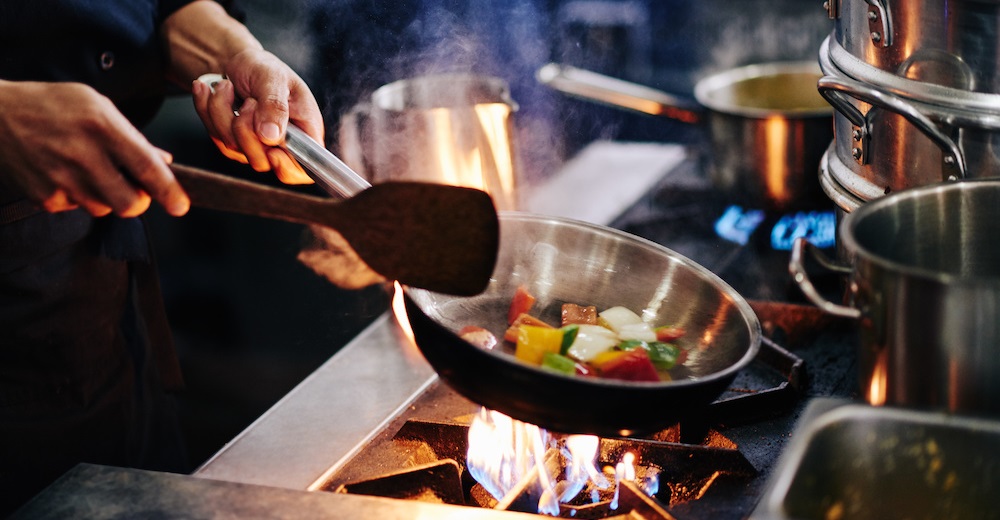
How Are Carbon Steel Pans Different from Cast Iron Pans?
Before we proceed with this article, it’s probably a good idea for us to list some of the ways that carbon steel pans are different from cast iron pans. Although these two types of pans are quite similar, there are some distinct differences between them, so let’s take a look at how they’re similar and how they’re different.
How Are They the Same?
- Neither should be washed in a dishwasher.
- Neither should be washed with a detergent.
- Both can generally be used on both a stovetop and in an oven.
- Both pans have to be seasoned before use.
How Are They Different?
- Carbon steel pans weigh less than cast iron pans.
- Carbon steel pans are less brittle than cast iron pans.
- Carbon steel doesn’t retain heat as well as cast iron.
What To Look for When Buying a Carbon Steel Pan
The next thing that we want to talk about is how to choose the best carbon steel pan for your needs. As we said earlier, there are dozens of great models of these pans available, but unfortunately, there are quite a few clunkers available as well. Therefore, it’s up to the consumer to make sure that they buy the best one available. Below are some things to look for when buying one of these pans.
Choose The Right Gauge
Although we won’t lecture our readers on pan thickness, most consumers are going to want to buy a pan that’s 15-gauge or under. The best carbon steel pans are between 10 and 15-gauge, which is approximately 2.59mm to 1.45mm thick.
Make Sure It’s Oven-Safe
It’s also a good idea to make sure the pan is oven-safe. Although cast iron is a material that can go from stovetop to the oven, a lot of manufacturers use silicone or plastic coatings on the handle of their pans that can melt if placed in an oven. Therefore, if it’s important to be able to use the pan in an oven, then make sure its handle will allow it.
Make Sure Its Handle Is Riveted
Consumers should also take the time to make sure that the handle is riveted to the pan using rivets made out of carbon steel as well. If a handle is screwed on to a pan, or if it uses rivets that are made of aluminum or some other material other than carbon steel, then they can loosen over time due to flexing caused by heat differences between the two metals. Carbon steel rivets on a carbon steel pan will simply last longer.
How To Season a Carbon Steel Pan
Now that we understand the differences between cast iron and carbon steel, it’s time to season that pan to create the perfect cooking surface and to prevent the pan from oxidizing. Below are the steps for seasoning a carbon steel pan.
Remove The Factory Wax or Grease Coating
The first step is to remove the wax or grease coating that was placed on the pan to protect it from oxidation during transit. Using hot water, dish soap and a stiff brush, thoroughly scrub the surface of the pan. When that’s done, dry the pan and place it on a burner to finish drying it. Now you can move on to the next step of removing the factory coating.
Place 2/3 cup of salt, 1/3 cup of oil and potato peels from 2 potatoes. Now place the pan on medium heat and move the peels and the salt around the pan. The peels and salt will help to remove any stuck-on factory sealant that might still be on the pan’s surface. Be sure to do not only the pan’s surface but also up to the sides of the pan as well. Rewash the pan thoroughly and then dry.
Season The Carbon Steel Pan
With the protective wax coating removed from the pan, the consumer can then season the pan. Seasoning the pan is important because it helps to create a non-stick cooking surface and also helps to protect the pan against oxidation. Let’s see how to season a carbon steel pan.
- Preheat oven to 400-degrees
- Place pan in oven while it’s preheating
- When oven reaches temperature, remove pan using oven mitts
- Using a quality cooking oil and a paper towel, apply oil over the entire pan
- Make sure to oil the handle and outside of the pan as well
- Place a foil-lined baking sheet on the bottom rack of the oven.
- Place the pan upside down on the top rack of the oven above the baking sheet
- Leave the pan in the oven for 1-hour
- After an hour, turn off the oven and let it cool down completely
- When the oven and carbon steel pan is cool, remove the pan from the oven
- Congratulations! The pan is now ready for use
